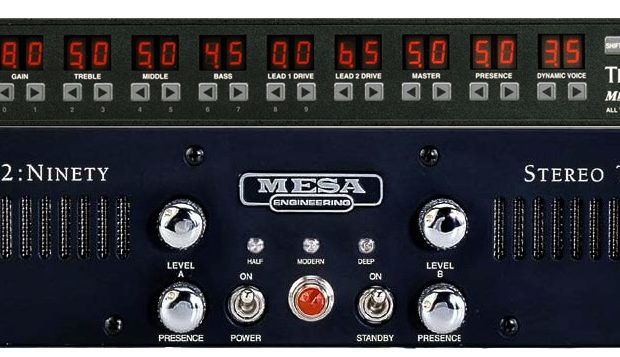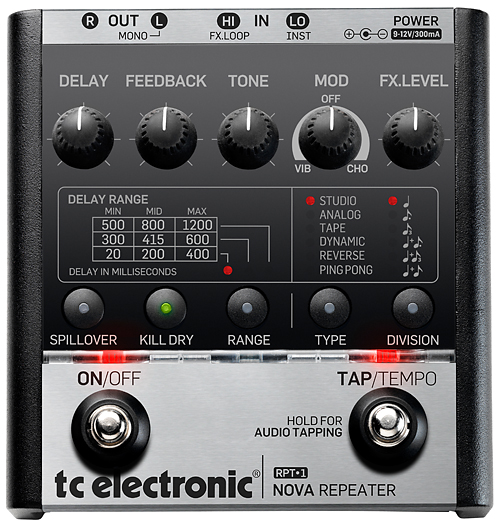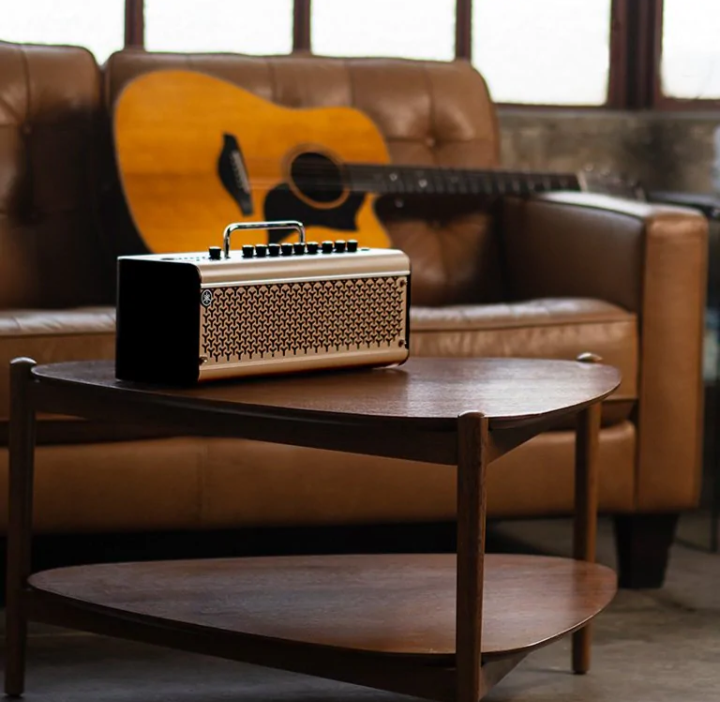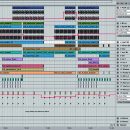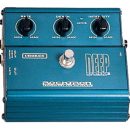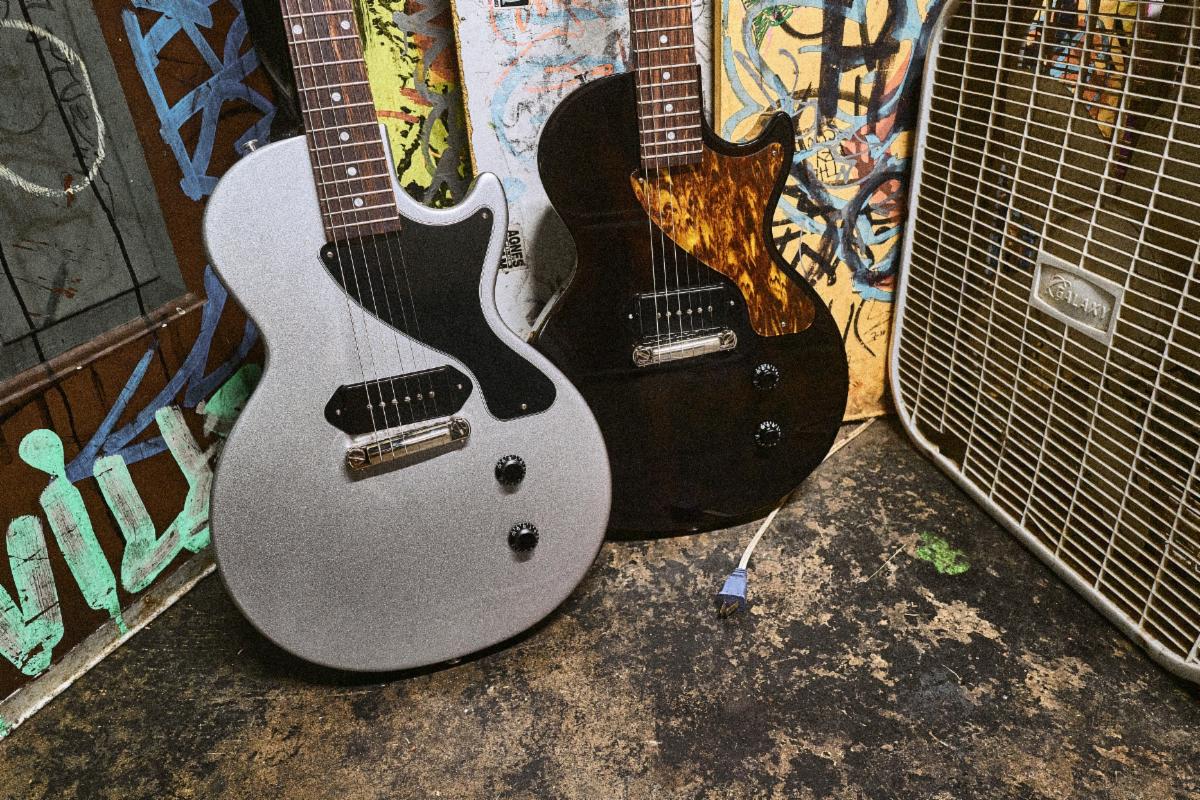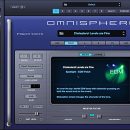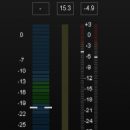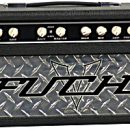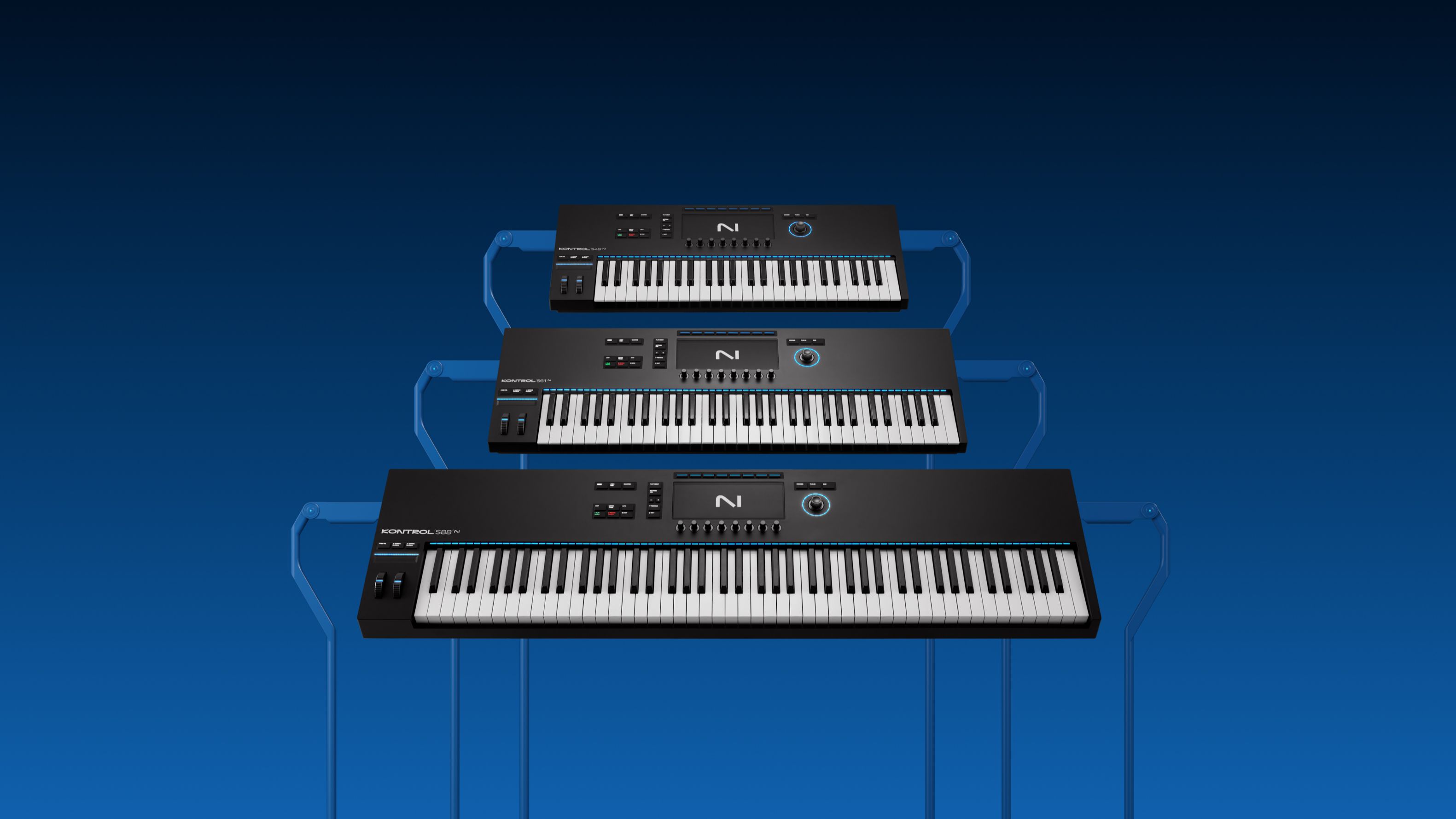Some products are so beloved that they remain mostly unchanged in a manufacturer’s product line for many years. The Triaxis is one such piece of gear: a fantastic sounding all-tube, MIDI-controllable, guitar preamp that when paired with the right power amp can deliver all the vintage Boogie tone discerning players crave, most notably the sound of Mark-series amps like the classic Mark IIC+ and Mark IV. Searing solos, famous fluty leads, prog metal rhythms or blues jams… the Triaxis dishes them up readily.
Although the Triaxis can be paired with many different Mesa/Boogie power amps (as well as power amps from any other manufacturer), if you’re specifically craving Mark-series tone, the 2:Ninety power amp is the unbeatable partner to this versatile preamp. If you think owning one Mark IV would be cool, consider that the 2:Ninety is, effectively, the power section of two Mark IV amps! Because it’s a stereo power amp, you get 90 Watts of Boogie’s famous Simul-class tube power delivered to each side. This two-space power amp delivers enough volume to cover the largest concert venue stage without breaking a sweat — even when running in half-power mode!
| Category | Value | Rating | ||||
| Features | 20% |
|
||||
| Usability | 25% |
|
||||
| Sound | 25% |
|
||||
| Documentation & Support |
10% |
|
||||
| Price | 20% |
|
||||
| OVERALL RATINGS: Mark Five = 3.5 Stars Mark Five 25 = 3.6 Stars, which earns it a WIHO Award! 3.6 stars or better: Outstanding, WIHO Award 3 stars or better: Worth considering 2 stars or better: Suited to specific needs 1 star or less: Not recommended |
||||||
Rack gear like this gives you the ultimate flexibility if you need a wide variety of tones from your amp. Forget about three and four-channel amps. With memory to save up to ninety of your favorite tone settings, and building those sounds out of eight different preamp circuits, it’s safe to assume that you’ll love more than a few sounds in this rig.
There have been a few revisions/modifications made to the Triaxis over the years, and players love to debate which version is the best sounding (details on the differences can be found in our Other Comments section). But we’re as happy with the current production model as those that came before it. Although we would love to see a few features updated or revised in a new version of this classic preamp, none of our gripes would stop us from playing a rig built around the Triaxis today.
For players with other preamps, the Simul-Class 2:Ninety is a gorgeous sounding power amp that has a few special tone-shaping options that can be selected via external switching jacks. And despite its potential for unleashing serious hearing damage driving as many as four 4x12 cabinets, the amp works great with a 2x12 stereo cabinet, too — just don’t expect to push this power amp into clipping territory without an attenuator!
Features
Triaxis Programmable Preamp
At first glance, the Triaxis looks like a digital monster, but don’t be mislead. Inside, it’s all tubes — five 12ax7s, and on the outside, controls for your volume, gain, EQ, and other tonal adjustments are easily controlled. The lack of knobs (other than the master volume output) means that you never have to worry about anyone accidentally (or deliberately) messing with your amp settings — great for the actively gigging musician.

The 1U high (single space) preamp has eight modes, and the guitar audio signal follows different circuit paths internally as the Triaxis delivers a range of tones taken from a few different classic Mesa/Boogie preamplifier designs. Colored LEDs on the face identify which preamp mode is in use (as described by Mesa/Boogie):
- Rhythm Green: Mark I, Blackface, vintage fat rhythm
- Rhythm Yellow: Mark IV, modern hyper-clean rhythm
- Lead 1 Green: Vintage Mark I Lead
- Lead 1 Yellow: Mark I Gain Boost Lead
- Lead 1 Red: British Lead (formerly called Dual Rectifier Vintage) Channel
- Lead 2 Green: Mid Gain Mark IV Lead
- Lead 2 Yellow: Classic Boogie Lead (Mark IIC+/Mark IV)
- Lead 2 Red: Searing Mark III Lead
Different preamp modes utilize different individual tubes in their circuits, and some obsessive players have even swapped out specific preamp tubes in order to further customize the sound of this preamp — as if it doesn’t provide enough choices already! (Note that this could invalidate your warranty, so skip the tube swap unless there’s something very specific you’re hoping to achieve.) The fifth 12ax7 tube is utilized as a buffer in the stereo return of the effects loop.
Controls on the front panel let you select your sounds (Presets and Programs — see Usability below) and dial them in: Gain, Treble, Middle, Bass, Lead 1 Drive, Lead 2 Drive, Master, Presence, and Dynamic Voice are adjusted with simple membrane-style Up/Down buttons. A master volume output is controlled via concentric knobs at the far right of the unit (stereo outputs).
Looking for the graphic EQ from a Mark-series amp? That’s what the Dynamic Voice feature provides, albeit in an abridged manner. The Triaxis has predefined five-band EQ curves based on popular settings on the Mark-series amps (illustrated in the documentation), and you can select those settings, as well as in-between values, to further customize (and sometimes radically alter) your tone.

The rear of the Triaxis contains stereo outputs and a serial effects loop (mono send, stereo return) that can be hard bypassed on a per-preset basis. There are also recording-compensated outputs (old school cabinet simulator), and four quarter-inch switching jacks that are used for triggering various modes within the 2:Ninety power amp, though you could use these for switching many other pieces of musical gear On/Off (or control a lighting rig, smoke machine, etc.).
The MIDI In port on the rear of the Triaxis has a 7-pin DIN connector capable of supplying phantom power to many foot controllers. Power is provided by your individual controller’s power supply — there is a wall-wart sized .220 mm pass-through barrel connector on the rear where you can attach a dedicated power supply.
Finally, the rear of the unit has the Input jack for your instrument signal and a ground-liftable power switch. There is no front-panel instrument input.
Players with advanced MIDI knowledge can also take advantage of using Continuous Controller (CC) messages to control various parameters in the Triaxis, too. Using an expression pedal that sends CC data, one or more of the preamp’s controls can be modified in real-time. For example, on one preset your pedal could control the level of Gain, while on another preset it could change your Bass, Mids, and Dynamic Voice. This advanced feature certainly opens up some interesting creative options!

Simul-Class 2:Ninety Power Amp
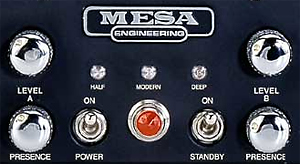 The 2:Ninety power amp is an undeniable leader in the world of rack-mounted power amps. Within a 2U space, it packs 90 Watts per channel (yes, that’s essentially a 180 Watt power amp) of Simul-Class power, the distinct power section that propels the sound of Mark IV and V amps.
The 2:Ninety power amp is an undeniable leader in the world of rack-mounted power amps. Within a 2U space, it packs 90 Watts per channel (yes, that’s essentially a 180 Watt power amp) of Simul-Class power, the distinct power section that propels the sound of Mark IV and V amps.
On each channel, two 6L6 power tubes operate in Class AB operation and two more operate in Class A mode. The resulting output is combined in a magic voodoo sort of way that creates the signature (and patented) tone of the Mark series. Obviously, if you want your Triaxis to nail the Mark-series tone, you’ll get the most comparable tone by pairing it with this power amp. Note: While the popular 2:Fifty amp sounds great with the Triaxis, it isn’t a Simul-Class amp and thus won’t give you the “true” Mark-series tone.
The 2:Ninety has more than just Level and Presence controls for each channel. Three switchable features include:
- Half Drive, which cuts the power output in half so that you can more easily push the power tubes. [Editor’s Note: Ha! Pushing these tubes…] Note that the amp pushes less signal into all of the tubes, so you’re reducing power output (good for tube longevity) but still using all of the tubes.
- Modern, borrowed from the Red/Modern channel of a Dual Rectifier Solo head (or the presence shift from a Mark IV), tightens up the sound and makes it more aggressive.
- Deep, which opens up the bottom end, extends the frequency response, and also warms up the high end.
These modes are activated via three quarter-inch input jacks wired for standard tip-to-ground connections. By now, you know the Triaxis has switching jacks to activate these features, but you can control them via any traditional switching system when used with other preamps.
Looking at the rear of the 2:Ninety… eight 6L6 power tubes? Holy cow! That’s a costly tube replacement when the time comes (or when your non-shock mounted rack falls out of the van)! But without all those tubes you would either lack Simul-Class technology or you’d have mono operation. And where’s the fun in that?
 There are jacks for connecting multiple 4 ohm and 8 ohm speaker cabinets as needed. [Tip: If you intend to use the 2:Ninety in mono operation, on the unused channel, make sure there is nothing connected to the input, set the Level control to its minimum and set the Presence control to its maximum value.]
There are jacks for connecting multiple 4 ohm and 8 ohm speaker cabinets as needed. [Tip: If you intend to use the 2:Ninety in mono operation, on the unused channel, make sure there is nothing connected to the input, set the Level control to its minimum and set the Presence control to its maximum value.]
One Classy Amp (err… make that two of them)
What the heck is this Class A/AB stuff? Listen up, as class is now in session (just a remedial course since the topic could warrant its own in-depth workshop). Class A power amp designs are the older, more vintage variety popularized in the Fender Tweed era. A constant voltage is applied to the tubes, which results in a more immediate response and smooth compression. But power output is more limited (so is headroom), and tubes may wear out faster from the constant voltage.
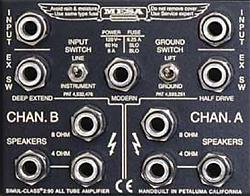 Class AB amps have lower plate voltages that are variable — signals below a certain threshold actually result in a tube being shut off. The advantages of an AB design include higher power ratings, more headroom, and tighter bass response, not to mention (typically) longer tube life since the tubes do not have voltage running through them at a constant rate.
Class AB amps have lower plate voltages that are variable — signals below a certain threshold actually result in a tube being shut off. The advantages of an AB design include higher power ratings, more headroom, and tighter bass response, not to mention (typically) longer tube life since the tubes do not have voltage running through them at a constant rate.
Credit Randall Smith with designing Simul-Class — his unique method of combining these seemingly disparate technologies to create one unique sound that overcomes the limitations of Class A operation while providing some of its positive attributes.
Usability
Triaxis Programmable Preamp
Using the Triaxis is pretty straightforward once you understand some quirks with the interface. First, you have to understand the difference between Presets and Programs — the two number selections at far left, sure to drive newcomers to this preamp batty.
Presets are your unique sounds — your clean rhythms, your heavy crunch tones, your searing leads, etc. Programs are MIDI program locations. Many pieces of MIDI gear have internal MIDI mapping features that map incoming MIDI Program Change (PC) messages to specific patch/preset settings. In the case of the Triaxis, they just happen to show you the settings on the face of the unit without having to dig into sub-menus to make changes. Bear with us and you’ll understand the application shortly.
This approach is particularly handy. Using any popular MIDI foot controller, you might want a MIDI Program Change (PC) value of 1 to call up Preset #1, and you might also want a PC value of 5 from your controller to call up Preset #1, too. You may want button #2 on your foot controller to call up Preset #14. To set up the MIDI mappings, all you do is select a Preset (your unique sound/tone), then change the desired Program value to whatever PC value you want to receive from your foot controller, and save the configuration with two taps of the Enter key. While it’s not the easiest feature to describe (particularly if you’re new to MIDI-controlled gear), a few minutes of experimentation will make it easy to understand.
Creating your guitar tone is more straightforward, though parts of the process are a bit tedious (and the primary area where the interface could use some updating). To choose a preamp voice, you press the Mode button, located next to the colored LED display. The Mode button cycles through the eight preamp modes, and each push is reflected by a different colored LED appearing on the display, scrolling through Rhythm Green to Rhythm Yellow to Lead 1 Green and so on.
The adjacent Loop SW (switch) button cycles through numerous options — this is the really tedious part of dialing in your Triaxis tones. Assuming you’ve connected three of the four switch jacks to your 2:Ninety’s switch input jacks, this button activates each of the switches individually or in various combinations together (for example, Half power and Deep, or Half, Deep, and Modern). The switch also cycles through jack 4, which is unused with the 2:Ninety but could be used with other external gear if needed, and then the Loop SW button also selects whether or not the FX Loop is active. We found ourselves sometimes making as many as twenty-four button pushes to select the right combination of switch options with the FX loop engaged, and if we passed our desired setting in haste, we had to scroll through all the settings to get back to where we wanted to be. One day we hope to see a Triaxis 2 that offers a less tedious way to select loop and switch options.
The Lead 1 Drive and Lead 2 Drive buttons are the principle gain controls for sounds within each Lead category. If you’re using a preamp voice such as Lead 1 Red or Lead 1 Yellow, you can set values for Lead 2 Drive, but they won’t do anything. It would be great if a future Triaxis turned off the display for the unused Drive control based on whatever preamp mode is in use.
Note that the preamp voice names should only be treated as rough guides. You’ll find hundreds of great rhythm tones within the Lead preamp circuits, just as you can build great classic rock lead tones out of the Rhythm modes.
The Dynamic Voice feature provides a very clever way of implementing the Mark-series five-band EQ without a physical EQ on the preamp. Although it requires a glance at the documentation to see how it impacts your tone, it was easy for us to dial in popular EQ curves for our tones. Setting values in between the ones illustrated in the manual create in-between settings that you’ll have to evaluate with your ears.
Many players like to start with an existing preset, tweak it to taste, and then re-save it. Imagine our surprise when we edited a few great sounds, saved them, turned Off our rack, came back the next day, and our sounds had reverted back to the original presets! Tip: The first twenty presets are protected from overwriting by default, but you can (and should) change this setting. Just hit the Shift key followed immediately by the Loop SW key to turn off this default setting. You can always restore the factory settings later should you want to get back to the preamp’s initial configuration, even long after you’ve overwritten the defaults.
The serial effects loop doesn’t have a dedicated level control and instead relies upon the Master Volume to control the send level. Assuming that your effects gear has a wet/dry mix control or input level controls, this shouldn’t pose much of a challenge, though we would have preferred more direct control. We had no trouble getting well balanced sounds out of some TC Electronic signal processors.
Simul-Class 2:Ninety Power Amp
The 2:Ninety is a very straightforward power amp to work with. The Left and Right input jacks have a selectable input level switch for either line or instrument level connections. For those of you who want to plug an acoustic-electric guitar straight into a power amp, feel free. But in our case, using this power amp behind a few different preamps, we left it set for line level.
When used with a Triaxis, many players will connect the first three switch jacks from the Triaxis to the three switch jacks on the 2:Ninety for controlling the Deep, Half-Drive, and Modern modes. Note that while we insist upon premium quality cabling for our rigs, there’s no need to spend more than a few dollars on these three cables — they don’t pass any audio signals.
Accessing the various modes within the 2:Ninety was a tedious process, as we mentioned earlier. If you want to run all of your heavy tones at half-power, for example, you have to reprogram all of your sounds with just the right switch settings. Setting various combinations of the modes with our effects loop required a lot of button pushing.
Fortunately, we found that it was extremely easy to bypass the Triaxis switching interface and control the power amp features directly any number of different ways. Since the jacks are standard tip-to-ground jacks, we connected them to our RJM Music Technology RG-16 switching system, which gave us direct, single-button access to those amp features. It was very handy while exploring Triaxis sounds to leave the power amp set for Modern or Deep, and we changed the default behavior in our rig (by reversing the switch output in the RG-16) so that ½ Drive was enabled as the default in the power amp. Because we use MIDI to select patches in our RG-16, it was simple to save various settings on our 2:Ninety for use with both the Triaxis and other preamps.
Alternately, you could plug some simple BOSS FS-5U switch pedals into the jacks for direct control of the amp.
Stereo rigs can be problematic for musicians gigging at the club level. Many clubs refuse to mic your amp in stereo! (One extra SM57 must cost them too much money.) Tip: If you’re forced to use a house-supplied backline, be prepared to suddenly use this amp in mono. If that’s what the gig calls for, simply unplug one input from the 2:Ninety and on that channel, turn the Level control down to zero and the Presence control to its maximum, otherwise you risk damaging the power amp.
Sound
We tested the Triaxis and 2:Ninety with multiple guitars including a customized Ibanez RG with DiMarzio Steve’s Special/Air Norton humbuckers, a Gary Kramer Guitars Cathedral Deluxe (Seymour Duncan JB and Jazz pickups), and a Music Man JP6.
Triaxis Programmable Preamp
There have been a few different revisions of the Triaxis over the years, and one thing holds constant for all of them. If you love Mark-series tone, the Triaxis delivers it in spades. There’s no other way to get the authentic sound of a Mark IIc+ or a Mark IV other than purchasing a pair of those classic Boogie amps.
Before we dive into the details, let’s cut to the chase and talk about the tone at a high level. Does a Triaxis/2:Ninety rig nail the tone of a Mark IV or a IIc+. Yes. Will a snobby, tone “purist” argue that rack gear doesn’t sound the same as the original amps? Yes. Should you listen to them for advice? No. They don’t get out much.
Joking aside, by its very design, the sound is not going to be 100% identical to, say, a Mark IV combo. For starters, the combo amp (or head) is commonly run as a mono amp, while the 2:Ninety delivers stereo operation. So if you are trying for an exact match to your Mark IV 1x12 combo, you’ll want to shut off half of the power amp. Of course, that’s an absurd thing to do since this rig delivers twice your daily allotment of Boogie goodness.
You’ve also got a few extra options that can be set on the power amp that could make your tone deviate from a precise historical tone. That said, you will get tone that is unmistakably Mark-series — think 95-97% historical tone accuracy if you need a number to feel good about. Nobody listening to you on stage or on a recording would think, “Oh, that sounds like a Triaxis rig.” They will think, “That’s a Mark IV. That’s a Mark IIc+” and they’ll feel nice and smug about having identified your signature sounds. But you’ll have much more flexibility to deviate from the obvious hallmark sounds than either of those two amps provide. This rig merely expands the palette of those classic amps in ways that are sure to please fans of the tone.
We have played the Triaxis preamp through many power amps: the 2:Ninety, which was designed specifically to be this preamp’s soul mate; the 2:Fifty, which sounds like a close second but lacks the expanded tonal palette offered by Deep, Modern, and Half-Drive settings (not to mention it’s not a Simul-Class amp); the older-generation Fifty:Fifty, which also sounds great and includes a handy (non-programable) Half-Drive switch (oddly missing from the newer model); and some random Marshall and Peavey power amps that feature EL-34 and EL-84 power tubes.
If you’re after a unique sound, feel free to pair the Triaxis with other power amps. That’s the beauty of rack gear — it’s so easy to create your own custom signature tone. Even within the Mesa/Boogie product line, you could pair the Triaxis with a Rectifier 2:One Hundred power amp that delivers a Dual Rectifier tone block, which responds significantly different from the Simul-Class amp in this review.
The recording outputs of the Triaxis are of limited value and shouldn’t be considered a feature when looking at this product. When introduced in 1990, these cabinet-simulated outputs were a leading-edge feature, but compared to modeling technology today, playing through them is kind of like playing through an old Scholz Rockman. Note: the Rectifier Recording Preamp has completely different simulated output than this older preamp.
Simul-Class 2:Ninety Power Amp
The 2:Ninety is very clean sounding, quiet (from the noise perspective), and extremely loud. By far its best use is when paired with a Triaxis preamp, as it delivers the complimentary Simul-Class power block that is at the foundation of Mark-series tone. The amp also sounds great paired with other preamps used in styles from blues to jazz to pop to classic rock, and if you’re setting up a multi-amp rig, it’s great for powering your stereo effects output.
Note that unlike a Mark IV or V, you don’t have the option to set the power amp for straight Class A operation, nor do you have the flexible tube-swapping options offered by those heads (installing a pair of EL-34 tubes, for example). So there may be some instances where you can’t nail the specific tone you favored in one of those amps.
We don’t find the 2:Ninety to be the best power amp in all circumstances. For some modern hard rock and metal players, the Simul-Class sound (or more specifically the silicon diode-based rectification) just won’t present the right sounding power block to your preamp. When paired with certain preamps, this power amp doesn’t deliver enough of the dirt some players desire (those players should really check out the Rectifier Stereo 2:One Hundred).
A Match Made in Heaven
Well, really it’s a match made in Petaluma, but really there is no better sounding combination than pairing the Triaxis and 2:Ninety with each other. And while there are useful sounds to be found in each of the preamp circuits, some of them are definitely better sounding than others.
For clean tones, we definitely gravitated towards the Rhythm Yellow mode. Compared to the looser and dirtier sound of the Rhythm Green voicing, this one is percussive and compressed, giving a nice woody tone to our clean rhythms. With the Gain set in the 5.0 — 6.0 range and mids at 3.0, it was easy to create glassy, chime-y tones with a bright bell sound. We also found great jazz tones in this voicing that would sound fantastic with a semi-hollowbody guitar. When we added some high gain to this channel, it never broke up on us, but rather just seemed to add more presence to the sound.
If you’re into vintage and classic rock tones, Lead 1 Green may be the preamp circuit for you. The clean tone was very similar to the sounds we got from our Mesa/Boogie Heartbreaker (Mark I re-issue), but slightly brighter in character overall. When we dialed in the dirt, the overdriven sound on this circuit sounded like vintage Marshall stuff. The manual mentions a JTM 45, and we’d have to agree.
Our love for this rig is especially apparent when playing in the Lead 2 Yellow and Lead 2 Red voicings. While the Lead 1 tones are based on the older Mark-series amps, the Lead II circuits are the stuff of classic IIc+ and Mark IV legend. Whether you’re into the bone crunching metal of Metallica or the prog metal edge that is delivered by Dream Theater, these tones will have you screaming for joy.
Lead 2 Red is the standout, delivering a very articulate attack that can keep up with the tightest, fastest rhythm picking. Kicking in the Deep voicing on the 2:Ninety turns the tone into seriously gut-wrenching devastation. You can just feel the low-end frequency rumbling through your gut, but the sound doesn’t get muddy. And that’s one of Mesa/Boogie’s hallmarks — heavy tone that preserves note separation.
Lead 2 Yellow is very similar in tone, but for flutey lead lines on your neck pickup, it might get our nod as the preferred channel, being just a hair cleaner. However, at low gain settings, this channel gets a little bit mushy. The character really changes when you dial in the gain.
Tip: For best results when crafting high-gain sounds on these channels, keep your Bass settings under 4.0 and match your Gain and Drive settings to within one or two numbers of each other.
In general, the most popular sounds (with modern rock and metal players) in the Triaxis rig come from the Lead 2 settings, but as with other boutique gear, you need to be up to the task of really playing these sounds. Inferior technique can be highlighted by this amp, which delivers very precise tone. If you’ve got a clean technique, this rig will be a monster in your hands. But a less skilled player may find many of the best tones too sterile for their taste.
Another thing to love about the Triaxis/2:Ninety rig is the silence. This is one of the quietest high-gain all-tube amps we’ve ever had the pleasure of playing through. There’s definitely no need for a noise gate in this rig. If only our Rectifier amps were this quiet!
Documentation and Product Support
Triaxis Programmable Preamp
The Triaxis documentation almost lives up to the legendary reputation that most Mesa/Boogie documentation is heralded for, and it’s quite lengthy. Of course, this is one of the older products in the Boogie lineup, and their documentation continued to evolve since this was written. However, some of the concepts could be better explained. Fortunately, though, there are huge legions of Triaxis users online if something isn’t clear enough to you in the documentation.
Simul-Class 2:Ninety Power Amp
Wow — the document that Mesa/Boogie forgot about! It covers the basic operation of the amp, the inputs and outputs, and the functionality of the switches. But there’s not even a schematic of the tube configuration — a very unusual absence from their usually-detailed manuals.
Price
Triaxis Programmable Preamp
The Mesa/Boogie Triaxis sells for $1,999. To have an arsenal of great Mark-series tones at your disposal, all under immediate MIDI control, the Triaxis offers a good value. Spend some time with one and you’ll understand why so many pros continue to rely on these incredibly versatile preamps.
Simul-Class 2:Ninety Power Amp
The Simul-Class 2:Ninety sells for $1,499, and is a great value. It’s one of the most widely used all-tube stereo power amps and can generate a wide range of tones thanks to the tone-sculpting features that can be used with any rig — not just a Triaxis.
Contact Information
Mesa/Boogie
www.mesaboogie.com
| Evaluation Short-List |
Tube Preamps
Tube Power Amps
|

